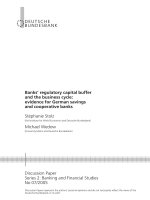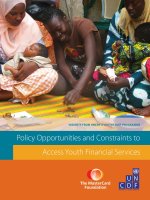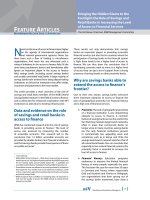Bringing the Hidden Giants to the Footlight: the Role of Savings and Retail Banks in Increasing the Level of Access to Financial Services docx
Bạn đang xem bản rút gọn của tài liệu. Xem và tải ngay bản đầy đủ của tài liệu tại đây (68.01 KB, 4 trang )
MICROBANKING BULLETIN, ISSUE 15, AUTUMN 2007
FEATURE ARTICLES
15
Microfinance Information eXchange, Inc
N
ever has the issue of access to finance been higher
on the agenda of international organisations
and national government agencies. Never has
there been such a flow of funding to microfinance
organisations. And never has one witnessed such a
string of initiatives in the access to finance field. At the
same time, practitioners, donors and beneficiaries alike
ignore an important player in the access to finance
field: savings banks (including postal savings banks)
and socially committed retail banks. A large majority of
savings banks have evolved from being deposit-taking
institutions to full-service institutions that offer credits,
insurances and payments to the mass market.
This article provides a short overview of the role of
savings and retail bank members of the WSBI (World
Savings Banks Institute)
1
in the field of access to finance
and as advocates for enhanced cooperation with MFI
institutions to add value to existing infrastructure.
Data and evidence on the role
of savings and retail banks in
access to finance
WSBI has conducted research into the role of savings
banks in providing access to finance
2
. The level of
access was assessed by measuring the number
of accessible accounts
3
. This research led to the
conclusion that 1.4 billion accessible accounts are
provided by double bottom line financial institutions
and that savings banks provide three quarters of these
accessible accounts
4
.
1
www.wsbi.org
2
WSBI (2006) “Access to Finance — What does it mean and how do savings
banks foster access” by Stephen Peachey and Alan Roe, WSBI Perspectives
49 and “Savings banks and the double bottom-line - A profitable and
accessible model of finance” by Stephen Peachey, WSBI Perspectives 52
3
Accessible accounts are defined as accounts provided by institutions
that target the mass market, such as microfinance institutions, credit
unions, cooperatives, agricultural and development banks and savings
and postal savings banks.
4
WSBI recognises that in addition to compiling data, it is important to
look into the “quality of access”. The WSBI intends to initiate further
research in this field.
These results not only demonstrate that savings
banks are important players in providing accessible
financial services, but also that in countries where the
participation of savings banks in the financial system
is high, there tends to be a higher level of access to
finance. We can thus draw the conclusion that if
developing countries want to move to a higher level
of access they can get a lot of support from a strong
presence of savings banks or other proximity banks.
Why are savings banks able to
extend the access to finance’s
frontier?
Due to their very nature, savings banks overcome
three important obstacles to access to finance: the
lack of geographical proximity, low financial literacy
and a high cost of financial services.
Proximity: The lack of geographical proximity
of a financial institution is one determining
obstacle to access to finance. A common
feature of savings banks across the world is the
fact that they maintain large branch networks,
often in areas that commercial banks no
longer serve. In many countries, savings banks
are the only financial institutions present
in commercially less appealing areas and
sometimes, such as in Kenya and Chile, the
savings bank branch network matches that of
all conventional banks. One can conclude that
especially in less mature financial systems, the
proximity factor is essential to increase the
level of access to finance.
Financial literacy: Education programs
endeavour to improve the limited financial
literacy of many people, especially the poor.
This has been the case for more than 50 years
in Germany and France, where respectively
Geld und Haushalt and Finance et Pédagogie,
two organisations that have sprung out of
the savings banks movement, have done a
Bringing the Hidden Giants to the
Footlight: the Role of Savings and
Retail Banks in Increasing the Level
of Access to Financial Services
Chris De Noose, Chairman, WSBI Management Committee
FEATURE ARTICLES
MICROBANKING BULLETIN, ISSUE 15, AUTUMN 2007
16
MICROBANKING BULLETIN, ISSUE 15, AUTUMN 2007FEATURE ARTICLES
Microfinance Information eXchange, Inc
pioneering job. Tremendous efforts are also
being delivered in developing countries
such as Thailand, where WSBI member GSB
(Government Savings Bank) has a “School
Based Savings Programme” in which students
recreate a savings bank in their class and
acquire the basic principles of personal
financial management via a “learning by
doing” method.
Along the same lines, savings banks offer
products that are simple to use and that
help customers with (financial) literacy
problems. This is the case of Banrural in
Guatemala which has created an ATM with
audio instructions in indigenous dialects
and biometric recognition for the clients
that cannot speak, read or write Spanish, the
official language of the country.
Cost of financial services: A third factor
constraining access is the cost of financial
services, which is paradoxically higher for
poor people, taking into account the higher
risks and the more expensive nature of the
operations needed to serve this segment.
In spite of this, financial institutions should
remain accessible for the most basic products,
such as the passbook savings account. This
product is standard of the savings banks’
product range. Generally it does not require
an entrance fee and most savings banks allow
for very low minimum balance requirements.
It is a highly accessible product that can be an
incentive for people to bring their money into
the formal financial system, instead of relying
on informal circuits.
In designing their products, savings banks take into
account the special needs and limitations of low-
income households as well as those of more affluent
customers. In developing economies, the minimum
amount for opening a savings account at a commercial
bank is often too high for a majority of the population.
In some countries, savers are required to deposit more
than their annual per capita income in order to open
a deposit account with a bank. In Benin and Senegal,
commercial banks often ask between US$100 and
US$200 in local currency to open a savings account.
Clients are also requested to maintain a minimum
balance, ranging between US$ 50 to 100. In addition,
bank fees to hold an account often exceed interest
paid for small deposit accounts.
In contrast, at the postal savings bank in Benin,
Burkina-Faso, Kenya and Tanzania, people can open
a savings account with less than US$10 and an even
lower amount in fees is required to keep this account
active. In other countries and in Latin America and
Asia, the figures also remain well below the average
requirement of the banking system.
The microcredit schemes of
savings banks
Although savings banks are savings mobilisation
specialists, it is misleading to think about them as
savings-only institutions. Research has shown that
across the developing world non-postal savings
Minimum fee to open a savings account at a Savings Bank
Country Institution Opening fee US$ Relative to % of per capita
income
Benin Caisse Nationale d’Epargne 10.00 2.5 %
Burkina Faso Caisse Nationale d’Epargne 10.00 4%
Chile Banco Estado 10.00 0.07
Colombia Banco Caja Social 8.00 0.09
Côte d’Ivoire Caisse d’Epargne et des
Chèques Postaux
20.00–40.00 2.5%
Kenya Kenya Post Office Savings Bank 7.00 1.9%
Malaysia Bank Simpanan Nasional 0.27 0.01%
Peru Cajas Municipales de Ahorro y
Crédito
10.00 0.5%
Senegal Postefinances 20.00 4%
Tanzania Postal Bank 5.00 1.8%
Thailand Government Savings Bank None None
Source: WSBI
Table
MICROBANKING BULLETIN, ISSUE 15, AUTUMN 2007
FEATURE ARTICLES
17
Microfinance Information eXchange, Inc
banks recycle half of their deposits as credits. But,
experts and other policy makers often overlook
microcredit plans run by savings banks. The two
experiences below from Colombia and Thailand
serve as illustration.
1. Banco Caja Social in Colombia was created
in 1911 with the mission to be the leading
bank for financing low to middle income
clients and micro-enterprises and small and
medium enterprises (SMEs). According to the
bank’s own estimates, in 2006 the micro credit
portfolio of Banco Caja Social represented
21.4% of the total Colombian micro credit
portfolio. Sixty-one percent of the bank’s
portfolio comes from clients with a monthly
income of less than 1.4 million Colombian
pesos - US$ 611.
Segmentation and innovation are strategic
pillars on which BCSC manages the
expansion of its services catering to the
needs of its target clientele. It has created
“Creemos,” a microfinance programme
targeting micro entrepreneurs with a
monthly sales turn over of less than US$
2,500. The loan is given taking into account
the client’s future payment capacity and is
not based on collaterals. Personal references
and overall household expenses are part of
the credit analysis.
Created in June 2004, the programme
counted in September 2005 already 4,259
customers and had granted US$ 3.58 million
with an average loan size of US$ 782. Past
due loans were 2.26% of the total portfolio.
Average savings in the account amounted
to US$ 125. Since then, the program has
expanded considerably; in 2006 more than
US$19.6 million was allocated in 23,347 credit
operations. By September, 2007, the project
has served 24,570 microentrepreneurs.
Seventy percent of these clients did not have
any relationship with the banking sector
before.
2. Government Savings Bank (GSB) of Thailand
has been very active in implementing policies
and measures to alleviate and eradicate
poverty in the country. Individually and in
collaboration with other financial institutions
and government agencies, GSB has provided
financial services under a number of
programmes, which include:
People’s Bank Program: This was
established by GSB to expand financial
opportunities to street vendors and other
small entrepreneurs through micro-
finance plans. GSB requires personal
guarantee or cross guarantee among the
group of borrowers as collateral. The micro
entrepreneurs need to save a specific
amount as a precondition for securing a
loan. GSB provides them with training. The
amount of each loan is decided on the
basis of the borrower’s investment need
and their ability to repay. The amount of
the first loan does not exceed US$ 750
and the borrowers can apply for a second
loan of up to US$ 1,250. A loan amount up
to US$ 375 must be repaid in 13 monthly
installments. The repayment terms of 25
months and 37 months apply for a larger
loan amount, not to exceed US$ 750
and US$ 1,250 respectively. In all cases,
there is a one-month grace period. Over
the first seven months of 2005, 108,599
loans, which amounted to US$ 78 million
were provided under the People’s Bank
Program. As of 31st July 2006, the project
had 1.3 million members.
Asset Capitalization Program: Launched
in 2004, this program intends to
create access to capital for the poor
to fund existing or new business
ventures. Documents guaranteeing
the lease rights for selling goods at
stalls administered by municipalities
and some government agencies are
used as collateral for loans. The loan
amount ranges from US$ 1,250 to US$
7,500 depending on the borrower’s
investment need. The interest rate is
12 % per annum and the repayment
term ranges from 3 to 5 years before
the expiry date of the lease right. As of
February 2, 2005, a total of 2,054 loans,
which amounted to US$ 4.12 million
were extended.
People’s Debt Restructuring Program: This
program was created to help over 700,000
non-agricultural debtors who owe
less than US$ 2,500 to unconventional
lenders. The branches of GSB take part
in the negotiations with creditors for
partial write-offs of the debts and then
refinance the remaining amount at a
18
MICROBANKING BULLETIN, ISSUE 15, AUTUMN 2007FEATURE ARTICLES
Microfinance Information eXchange, Inc
lower interest rate. GSB also provides
debtors with occupational training. As of
August 31, 2005, 8,868 debtors refinanced
the total debt of about US$ 9.5 million
from unconventional lenders through
this program.
A very important aspect of these projects is that they
are not conducted separately from the mainstream
banking activities. Some of the MFI clients upgrade
from the microfinance customer segment to the
SME segment or the private customer segment. The
microcredit scheme is thus a fully-fledged product
that fits seamlessly in the total product range.
Potential opportunities for
cooperation between savings
banks and MFIs
There are two fields where a closer link between
savings banks and MFIs would be directly and mutually
beneficial: linking savings to microcredits and linking
remittances to microcredits. An alternative for savings
and retail banks to offering microcredit services
directly to the end beneficiary could be to establish
alliances with microfinance institutions.
Linking savings to microcredits: Offering
savings services requires a high level of
institutional development to meet safety
and soundness requirements. Indeed, a
large and widespread physical banking
infrastructure is essential to collect the often
small amounts of savings, and maintain them
at the disposal of the client on a permanent
basis. It requires skilled staff, good treasury
management and adequate control and
audit structures.
Instead of going down this road on their
own, it would undoubtedly be beneficial for
microfinance institutions to partner with
savings banks. Microfinance institutions
could concentrate on the analysis of the
creditworthiness and the repayment capacity
of their clients, a domain where they have a
high level of expertise, while savings banks
could make use of their front and back office
systems for disbursing of loans and collecting
loan repayments.
Another promising track for savings
banks is to invest their savings deposits in
microfinance institutions by specialising
in wholesale lending to microfinance
institutions for lending to their micro
borrowers. Savings banks could refinance
well-functioning microfinance institutions
individually or indirectly through an apex
institution.
By combining strengths, the savings banks
on the deposits collecting side and the MFIs
on the credits side, both types of institutions
could contribute substantially to the creation
of a strong financial system.
Linking remittances flows to microcredit
products: Savings banks have a natural
role to play in the remittances business the
senders and receivers of remittances are
mainly individuals and small businesses, the
traditional target client group of savings
banks. By capturing and channelling more
of the remittances into the financial system
and intermediating the flow of the resources,
savings banks contribute to leveraging the
positive impact of these transfers.
In several savings banks, efforts have been
undertaken to encourage those who live
abroad to save at home, which is the case at
Hatton Bank in Sri Lanka. The specific savings
programme this bank has developed entitles
the client to a microloan of five times the
amount saved over a certain period of time.
Linking remittances flows with microcredit
products is an area of increased interest in
savings banks and is another area where
collaboration with microfinance institutions
would be mutually beneficial. We see
opportunities in allowing the direct repayment
of microcredits with remittances income and
in using the remitter’s assets as collateral.
Conclusion
Despite their longstanding commitment and their
tremendous efforts in the field of access to finance,
savings banks still seem to be the invisible players
in the arena. It is clear however that cooperation
between the various financial institutions active in
the field of access to finance is essential to increase
substantially the number of people who have
access to financial services. Rather than trying to
achieve this alone, savings banks call for a closer
collaboration with the microfinance institutions in
the field.









